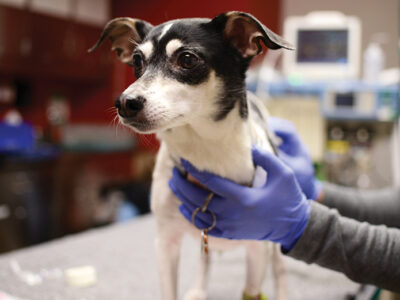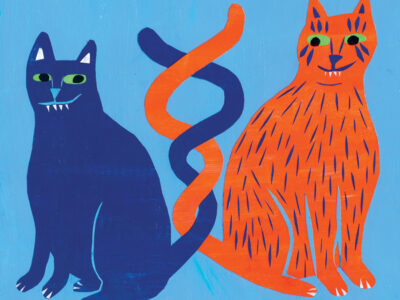LEO, AN AGING PERSIAN, and Tiger, a rough-and-tumble tabby, may not appear to have much in common. But they owe each other — and a new procedure at the Veterinary Hospital of the University of Pennsylvania — their lives.
By last December, the elder cat had grown so weak from polycystic kidney disease that he had to be carried around by his owners, Kathy and Peter Karamolengos, of Springfield, Pa. The only thing that would save their beloved pet, they had been told, was a kidney transplant. So when they learned that VHUP was starting its own feline renal-transplant program — one of only a handful on the East Coast — they quickly contacted the person in charge of the procedure, Dr. Lillian Aronson, V’92, INT’93. In late February, Leo became the program’s first patient. Before long, the Karamolengoses brought home not only their own, healthier cat but Tiger, the donor of that life-saving kidney.
VHUP has made arrangements with the local SPCA to identify potential donor cats, such as Tiger, who would otherwise be euthanized. And in return, these cats must be adopted by the owners of the kidney recipients. “The nice part about it is the owner feels that they’re not only helping their own cat, but saving the life of the donor cat who would otherwise be euthanized,” says Aronson, assistant professor of surgery at the School of Veterinary Medicine. “The families typically become quickly attached to the donor cats.”
Now when people bring cats that they don’t want anymore to the animal shelter, they are told about Penn’s program and asked if they would like their pet to be part of it — and to be guaranteed a home.
The transplant program began a decade ago at the University of California-Davis, where Aronson completed her surgical residency. VHUP brought her back last year to start one of its own programs, and so far 12 cats have received kidney transplants at the hospital.
Aronson estimates she gets “probably about five calls a day, plus e-mails,” from cat owners who hope to get their pets on a waiting list for the procedure. She looks for transplant candidates who have no other underlying diseases or infections, and who haven’t lost too much of their body weight yet. “I guess for the right cat it’s an excellent treatment,” she says. “It’s not for every cat. Owners need to realize that they are taking a cat with an underlying fatal disease and putting it through a big procedure.”
The entire process, which requires about two weeks in the hospital for pre-medication, surgery, and recovery, costs about $5,000. The operations on donor and recipient are performed simultaneously and involve the work of three surgeons. Usually, the kidney is transplanted within an hour of its removal from the donor cat. The diseased kidneys are left inside the recipient, because they often have some function and can assist the patient in case the transplanted organ takes some time “to kick in.” To prevent his body from rejecting the new organ, the kidney recipient must be given medicine every day for the rest of his life.
As for 11-year-old Leo, his new kidney performed marvelously, but he had to undergo a second surgery at VHUP in March to have an abnormal parathyroid gland removed from his neck. “He’s recovered his strength,” Kathy Karamolengos reports, “and he’s been doing very nicely ever since.” She calls Aronson “the most dedicated vet I’ve ever met.”
The Karamolengoses, who already owned three cats, didn’t mind adding a fourth feline to their home. “He’s a very healthy, alert, very active young male. He beats up on everybody,” she says of the two-year-old, aptly-named Tiger. “He’s a tough customer. He makes us laugh because he does such crazy things.”
Restoring Leo’s health has been a costly undertaking for the Karamolengoses, who estimate that since their cat got sick, they have spent more than $12,000 — on a specialist, ultrasounds, a prior hospitalization, and the two surgeries at VHUP, as well as ongoing bloodwork and medication. “Our friends think we’re crazy,” says Kathy. “I’m grateful the cat is well. We didn’t set out to spend this kind of money, but it happened. And without [VHUP], we wouldn’t have our cat alive today.”
Asked about the expense of this procedure at a time when some people are getting inadequate treatment, Dr. Arthur Caplan, the Trustee Professor of Bioethics in Molecular and Cellular Engineering who serves as director of the Penn Health System’s Center for Bioethics, responds: “It’s probably just not fair to say that money going for animals would be available for people. They probably are on separate tracks. The real issue is that in trying to offer high-tech procedures to pet owners, you’ve got to deal with very complicated emotions and powerful feelings. Ethical people will make sure that people can reject high-tech procedures without guilt, and unethical people — not us, of course — would exploit or abuse the powerful emotions, feelings, and ties that people have to their pets.”
Saturday, July 5, 2025
Popular
Administration
Anniversary
Archaeology
Architecture
Art
Awards
Books
Calendar
Campus Life
Commencement
Education
Elsewhere
entrepreneurs
Events
Exhibition
Expert Opinion
Faculty
Film
Football
Gifts
Health
Healthcare
Heard on Campus
History
International
Leadership
Medicine
Men's Basketball
Music
notes
obits
painting
Penn Medicine
Penn Museum
Philadelphia
Photography
Poetry
Politics
Science
Student Life
Technology
Television
Theater
Wharton
Window




